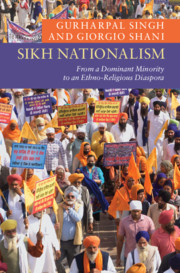Book contents
- Sikh Nationalism
- New Approaches to Asian History
- Sikh Nationalism
- Copyright page
- Contents
- Maps
- Figures
- Tables
- Acknowledgements
- Abbreviations
- Glossary
- Introduction
- 1 Understanding Sikh Nationalism
- 2 Sikhism and the Sikhs up to the 1890s
- 3 The Emergence of Modern Sikh Nationalism, 1880s–1930s
- 4 The Partition of India and the Sikhs, 1940–1947
- 5 The Indian Union and the Sikhs, 1947–1984
- 6 Militancy, Antiterrorism and the Khalistan Movement, 1984–1997
- 7 Sikh Nationalism in the Age of Globalisation and Hindutva, 1997 to the Present
- 8 The Diaspora
- Conclusion
- Timeline
- Appendix: Anandpur Sahib Resolution
- References
- Index
- New Approaches to Asian History
Conclusion
Published online by Cambridge University Press: 19 November 2021
- Sikh Nationalism
- New Approaches to Asian History
- Sikh Nationalism
- Copyright page
- Contents
- Maps
- Figures
- Tables
- Acknowledgements
- Abbreviations
- Glossary
- Introduction
- 1 Understanding Sikh Nationalism
- 2 Sikhism and the Sikhs up to the 1890s
- 3 The Emergence of Modern Sikh Nationalism, 1880s–1930s
- 4 The Partition of India and the Sikhs, 1940–1947
- 5 The Indian Union and the Sikhs, 1947–1984
- 6 Militancy, Antiterrorism and the Khalistan Movement, 1984–1997
- 7 Sikh Nationalism in the Age of Globalisation and Hindutva, 1997 to the Present
- 8 The Diaspora
- Conclusion
- Timeline
- Appendix: Anandpur Sahib Resolution
- References
- Index
- New Approaches to Asian History
Summary
The conclusion summarises the core argument of the volume. It maps the nature of Sikh nationalism today within South Asia and the diaspora on a continuum of groups that seek an independent homeland of Khalistan to those that pursue autonomy within the Indian Union and others that demand equality, recognition and non-discrimination within the Indian Union and the diaspora. It also reflects on the political and social integration of Sikhs within the Indian Union and the prospects of an independent Sikh state in light of state- and nation-building in India and Pakistan and China’s growing assertiveness in north-west South Asia. The Sikh case, it is argued, raises important methodological issues for the comparative study of ethnicity and nationalism – the need to include socially complex minorities like the Sikhs and the Jews, the role of such minorities in supporting consociationalism arrangements in colonial administrations, and their contribution to the cultural democratisation of the public sphere in Western liberal democracies. The Sikh case is also an example of the ‘nationalism of small peoples’, a ‘nation without a state’ and, more recently, of ‘nation-destroying’. The work concludes with a plea to take the study of Sikh nationalism seriously.
- Type
- Chapter
- Information
- Sikh Nationalism , pp. 211 - 218Publisher: Cambridge University PressPrint publication year: 2021

